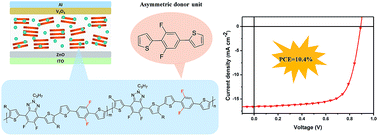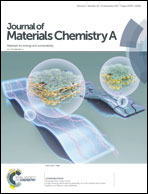A random donor polymer based on an asymmetric building block to tune the morphology of non-fullerene organic solar cells†
Abstract
Non-fullerene organic solar cells (NF-OSCs) require donor polymers with different morphological properties from those used in fullerene devices to achieve optimal cell performance. In this paper, we report a random donor polymer (PTFB-M) constructed from an asymmetric donor unit (T–FB–T-M), which can effectively tune the morphology and thus enhance the performance of NF-OSCs. Compared with its analog polymer PTFB-P based on a C2 symmetric monomer, the asymmetric T–FB–T-M unit introduces some randomness in the PTFB-M polymer yielding several beneficial effects. Firstly, although the neat PTFB-M film exhibits slightly reduced crystallinity and hole mobility compared to PTFB-P, it can, to our surprise, better maintain its crystallinity when blended with non-fullerene acceptors, hence yielding NF-OSCs with higher hole mobility and fill factors (FF) compared to devices based on PTFB-P. In addition, PTFB-M also exhibits smaller and more favorable domain sizes in NF-OSCs, leading to higher external quantum efficiency (EQE) and short circuit current density (Jsc). As a result, when combined with a small molecule acceptor (SMA) ITIC-Th, PTFB-M yields a power conversion efficiency (PCE) of 10.4%, whereas the PCE is only 8.4% for PTFB-P:ITIC-Th-based cells. This provides a useful approach to tune the morphology of donor polymers and to enhance the performance of NF-OSCs.



 Please wait while we load your content...
Please wait while we load your content...